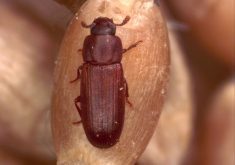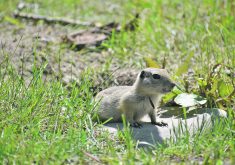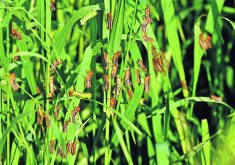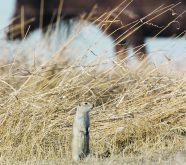ROSEMARY, Alta. — Alfalfa weevil control required as many as six insecticide applications for some southern Alberta alfalfa seed growers this year.
Gerald Wiens was one of them.
A sweep net revealed the need to spray for weevils, but a few days later another sweep showed yet another hatch of the damaging insects.
“I kept thinking I was getting about half every time,” Wiens told growers on an Alberta Alfalfa Seed Commission crop tour July 28.
“I wouldn’t recommend six applications, but that’s what we did to keep things at bay. There’s got to be a better way than that.”
He speculated that a cool spring resulted in a longer egg-laying period for the weevils, which in turn extended the hatch.
Humidity or excessive heat during spray applications might also have played a role in poor results.
Other farmers suggested that weevils are developing resistance to synthetic pyrethroids such as Decis and Matador, which are the main weapons in the arsenal against alfalfa weevils.
Brian Slenders, an alfalfa seed grower who has handled various research projects for the commission, said this year’s experience sounds a warning.
“The take away from this is we need to be very conscious about what chemistries we’re using out there and be very judicious in rotation of chemicals … as much as we can,” Slenders said.
Read Also

Farming Smarter receives financial boost from Alberta government for potato research
Farming Smarter near Lethbridge got a boost to its research equipment, thanks to the Alberta government’s increase in funding for research associations.
Alfalfa seed grower Fred Preston recounted similar difficulties with alfalfa weevil control this year. He sprayed four times, starting with a Malathion application in early June that didn’t have much effect.
“June 10, Matador worked a little better. June 22, Matador did not work. July 4, by this time I’ve got numbers of 80 weevils per 180 degree sweep,” said Preston.
Alberta Agriculture recommends spraying when there are 20 to 25 weevils per 90 degree sweep.
“There was some evidence of chewing, but it was not mowed off. So I did full rate Coragen, 200 mills per acre. That seemed to work. Death was slow but evident. Every day the numbers dropped,” he said.
“Luckily I didn’t ask how much that cost per acre until after — $42 per acre plus application. Whether the Coragen worked or Mother Nature worked, the numbers went down, so happy day.”
Coragen, with the active ingredient chlorantraniliprole, is a Group 28 chemical marketed by DuPont.
The field tour also visited Jerry Martin’s field south of Rosemary, where aphid numbers were severe earlier this year. Several applications of Matador were required to obtain control.
However, that delayed farm managers from putting leafcutter bees into the field, so the crop was delayed by at least a week.
Insecticide options are limited for seed growers because they require leafcutter bees to pollinate the crop. Coragen is a relatively new option that doesn’t kill bees but prevents the weevils from chewing, so they eventually die of starvation.
However, that process can take awhile, so it required growers’ patience.
“It can take at least a week … and it isn’t 100 percent either,” said Slenders. “General kill is around 75 percent.”
Alfalfa weevils are a common problem in seed crops and the area north of Brooks and around Enchant are reported to have been particularly hard hit this year.
Both the adults and larvae feed on crops, but larvae do most of the damage, which can be significant in large numbers.


















